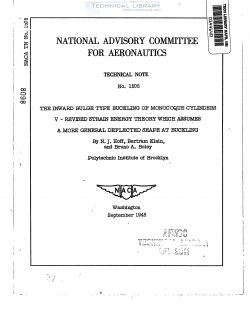naca-tn-1505
- Version
- 146 Downloads
- 1.75 MB File Size
- 1 File Count
- December 4, 2016 Create Date
- December 4, 2016 Last Updated
National Advisory Committee for Aeronautics, Technical Notes - The Inward Bulge Type Buckling of Monocoque Cylinders - V - Revised Strain Energy Theory which Assumes a More General

A strain energy theory is developed for the calculation of the crit-
ical load for the inward bulge type of general instability of reinforced
monocoque cylinders subjected _to pure bending. The deflected shape at
buckling is assumed to be represented by an expression containing eight
free parameters in addition to the two characterizing the wave lengths in
the circumferential and axial directions. The theory is applied to two
representative cylinders of the GALCIT test series and to two of the
PIBAL series. The critical stresses calculated are 8. 3 to 22 9 percent
higher than the experimental values.
When a reinforced aluminum-alloy monocoque fuselage is subJected to
bending moments, such as those caused by the aerodynamic loads acting
upon the tail surfaces, structural failure is likely to occur by the
buckling of the stringers on the compression side of the fuselage. The
half wave length of the deflected shape is emial to the spacing of the
ring frames when the frames are comparatively rigid and are spaced far
apart. The critical: stress can be increased by spacing the rings closer,
but at the same time the cross-sectional dimensions of the rings must be
made smaller in order to keep the weight of the structure unchanged.
Such a, trend can be noticed in the development of the modern monocoque
fuselage from 1930 until the present time. When, however, the distance
between rings and the cross section of the ring decreases beyond a certain
Limit, the rings no longer have sufficient bending rigidity to act as
rigid supports for the stringers. In such a case failure occurs by general
instability in which several stringers and rings are involved simultaneazsly.
The general instability of a. reinforced thin-walled curved shell was
first investigated by Dschou in 1935 (reference 1) who, at the ggesticn
of H. Wagner, worked out and applied to monocoqaes the buckling 1eory of
orthotropic shells established in 1932 by Fliigge (reference 2). A
similar theory was worked out independently by Taylor (reference 3)
in 1935. In these investigations a uniformly distributed compressive
loading was assumed. It was believed that the results would also apply
in the case of bending provided that the wave length in the circumfer-
ential direction were small enough so that the variation in the intensiiy
of the comressive stress caused by the bending moment could be disre—
garded. At the same time the wave length must be greater than the spacing
of the reinforcing elements. Otherwise the structure cannot be considered.
as an orthotropic shell. The results of these theories were compared
later with experiments carried out at GALCIT in 1939 (references ’+ to 8).
It was found that the buckling loads predicted were several times as h1g1
as those observed.
| File | Action |
|---|---|
| naca-tn-1505 The Inward Bulge Type Buckling of Monocoque Cylinders - V - Revised Strain Energy Theory which Assumes a More General.pdf | Download |

Comment On This Post